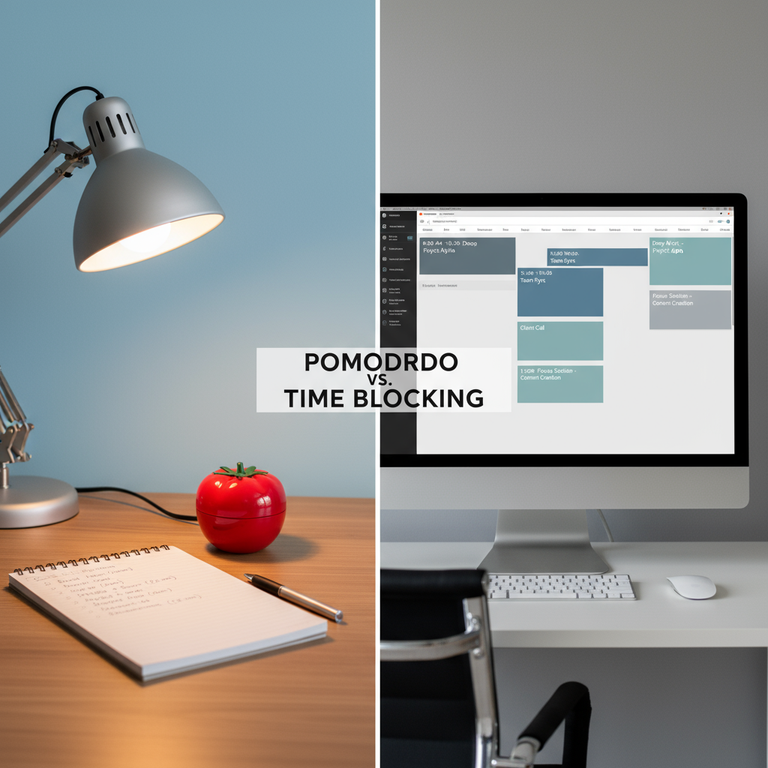Pomodoro Technique vs. Time Blocking: Which Method Wins in Practice? (Analysis)
In the vast universe of productivity systems, two titans consistently battle for the top spot: the Pomodoro Technique and Time Blocking. Both are praised by high-performers, and both promise to deliver you from the chaos of distraction into a state of focused, meaningful output. Yet, many professionals try one, find it doesn’t “fit” their workflow, and abandon it, declaring the method a failure.
The problem is rarely the method itself; it’s a “tool for the job” mismatch. We’re asking which is “better” without first asking what problem we’re trying to solve. Are we fighting procrastination and a short attention span? Or are we fighting a chaotic schedule and a lack of planning?
This article is a practical analysis of the Pomodoro Technique vs. Time Blocking debate. We will dissect the mechanics, the core psychology, and the ideal use case for each. The answer isn’t about which method wins, but about *when* each method wins, and how to combine them for an unstoppable productivity system.
What is the Pomodoro Technique? (The Focused Sprint)
The Pomodoro Technique, developed by Francesco Cirillo in the 1980s, is a system for managing focus. It is brilliantly simple. The “Pomodoro” (Italian for “tomato,” named after his tomato-shaped kitchen timer) is a 25-minute, uninterrupted block of work.
The Mechanics:
- Choose a single task to work on.
- Set a timer for 25 minutes.
- Work with 100% focus on that task. No email, no phone, no distractions.
- When the timer rings, mark your “Pomodoro” as complete.
- Take a 5-minute break. (This is mandatory. Get up, walk around, get water.)
- After four Pomodoros, take a longer break (15-30 minutes).
The Core Psychology: Why It Works
The Pomodoro Technique is not a planning system; it’s a *psychological* tool to combat procrastination and distraction.
- It Lowers “Activation Energy”: The hardest part of any task is starting. “Write the report” is a huge, intimidating task. But “work on the report for just 25 minutes” is a small, manageable, non-threatening request. It tricks your brain into beginning.
- It Gamifies Work: It turns your workday into a game. Can you collect 8 Pomodoros today? This “collecting” mindset provides a small dopamine hit for finishing a *sprint*, not just a project, which keeps motivation high.
- It Manages Energy: It forces you to take breaks. This prevents burnout and respects your brain’s natural “ultradian rhythm” (the need to cycle between focus and rest).
Analysis: Pros and Cons
Pros:
- Excellent for fighting procrastination.
- Improves focus and attention span over time.
- Reduces burnout by forcing breaks.
- Great for tasks that are vague or overwhelming.
Cons:
- The 25-minute sprint can interrupt “flow state” (deep, creative focus) just as it’s getting good.
- The 5-minute break can easily turn into a 20-minute distraction.
- It doesn’t help you *plan* your day or prioritize *what* to work on.
What is Time Blocking? (The Intentional Blueprint)
Time Blocking is a system for *planning* your time. Where Pomodoro manages your focus *within* a task, Time Blocking manages your *schedule* of tasks. It’s the practice of dividing your entire day into pre-planned blocks of time, with each block dedicated to a specific task or batch of tasks.
The Mechanics:
- At the end of each day (or the start of each week), look at your “to-do” list.
- Estimate how long each task will take.
- Open your calendar and “block out” specific times for each task.
- Example: 9-10 AM: “Answer all client emails.” 10-12 PM: “Deep Work: Draft Q3 Proposal.” 12-1 PM: “Lunch (No Work).” 1-2 PM: “Team Meeting.” 2-3 PM: “Admin tasks.”
- You live by your calendar. If it’s not on the schedule, it doesn’t get done.
The Core Psychology: Why It Works
Time Blocking is a psychological tool for creating intention and eliminating decision fatigue.
- It Defeats “Parkinson’s Law”: Parkinson’s Law states that “work expands so as to fill the time available for its completion.” By giving a task a specific, finite block (e.g., 60 minutes for email), you force yourself to be efficient.
- It Eliminates Decision Fatigue: The average person makes thousands of decisions a day, many of them “What should I do next?” Time Blocking makes that decision for you in advance. You just look at your calendar and execute, preserving your valuable mental energy for the work itself.
- It Protects Your Priorities: It forces you to put your “big rocks” (your most important deep work) into the calendar *first*, ensuring they get your best energy, rather than just the “leftover” time after meetings.
Analysis: Pros and Cons
Pros:
- Excellent for “deep work” and complex, project-based roles.
- Gives you a realistic, comprehensive plan for your day.
- Prevents shallow work (like email) from taking over your schedule.
- Reduces stress by removing the “what’s next?” anxiety.
Cons:
- Can be very rigid and fragile. One unexpected meeting or phone call can “break” your entire day’s schedule.
- Requires significant discipline and planning upfront.
- It can be hard to accurately estimate how long tasks will take.
The Core Debate: Pomodoro Technique vs. Time Blocking
The Pomodoro Technique vs. Time Blocking debate is a false dichotomy because the methods solve two completely different problems.
The Pomodoro Technique solves a FOCUS problem. It’s a “bottom-up” micro-managing tool. It’s for the person who sits down to work but finds themselves on social media 10 minutes later. It doesn’t care *what* you work on; it just cares *how* you work on it (in 25-minute sprints).
Time Blocking solves a PLANNING problem. It’s a “top-down” macro-managing tool. It’s for the person who has a dozen competing projects and needs to create a strategic “blueprint” for their day. It doesn’t care *how* you do the work in the block; it just cares that you *are* working on the intended task.
Asking which is better is like asking if a hammer is better than a screwdriver. It’s the wrong question. The right question is, “What am I trying to fix?”
The Verdict: Which Method Wins (For You)?
When to Use the Pomodoro Technique:
You should default to the Pomodoro Technique if:
- You are a chronic procrastinator.
- You get easily distracted by your phone or email.
- You are feeling burned out (the forced breaks are a non-negotiable recovery tool).
- You are working on a long, “un-finishable” task (like “studying for an exam” or “cleaning the garage”).
- Your work is mostly a “to-do list” of small, unrelated tasks.
When to Use Time Blocking:
You should default to Time Blocking if:
- Your job requires significant “deep work” (e.g., programmer, writer, strategist, designer).
- Your schedule is packed with meetings, and you need to *defend* time for your own projects.
- You are a manager or leader who needs to balance your own work with your team’s needs.
- You feel “busy” all day but have nothing to show for it (you’re stuck in reactive, shallow work).
The Hybrid Solution: The Ultimate Productivity System
Here is the “Oráculo” insight: High-performers don’t choose. They integrate. The real “winner” of the Pomodoro Technique vs. Time Blocking debate is the professional who uses them *together*.
This “hybrid” method gives you both the high-level plan and the low-level focus. It’s the best of both worlds.
Step 1: Use Time Blocking to plan your week.
Look at your projects. Be realistic. Block out your calendar with your priorities. Your calendar might look like this:
- 9:00 AM – 9:30 AM: “Email Triage” (Time Block)
- 9:30 AM – 12:00 PM: “Deep Work: Write Project X Report” (Time Block)
- 12:00 PM – 1:00 PM: “Lunch (No Work)” (Time Block)
- 1:00 PM – 2:00 PM: “Admin Tasks & Invoicing” (Time Block)
Step 2: Use the Pomodoro Technique to execute your blocks.
Now, when your 9:30 AM “Deep Work” block arrives, you don’t just “stare at it.” You *execute* it with the Pomodoro Technique. That 2.5-hour block (150 minutes) is perfect for five 25-minute Pomodoro sprints with four 5-minute breaks.
This solves the core weakness of both methods. Time Blocking provides the structure, and the Pomodoro Technique provides the *gas* to get the work done within that structure. It prevents you from “breaking” your time block to check social media, and it prevents the Pomodoro technique from being just a series of random, unplanned sprints.
Conclusion: Stop Choosing, Start Integrating
The Pomodoro Technique vs. Time Blocking debate is ultimately flawed. One is a screwdriver, and one is a hammer. Both belong in your productivity toolbox. The practical winner is the “hybrid” approach.
Use Time Blocking as your “CEO” to create a strategic plan for your day. Then, use the Pomodoro Technique as your “Manager” to execute that plan with relentless, interruption-free focus. This combination creates a robust, flexible, and sustainable system that respects both your time and your energy, which is the true foundation of all high-performance work.







